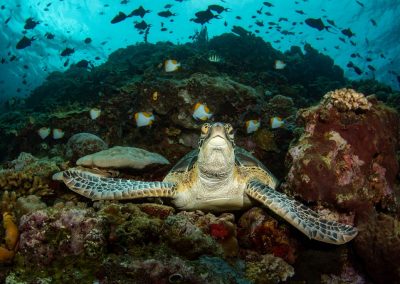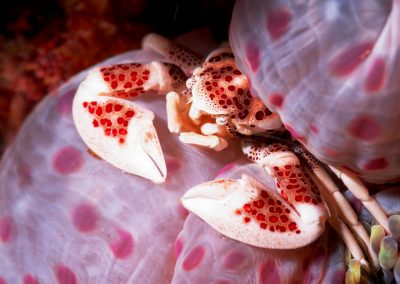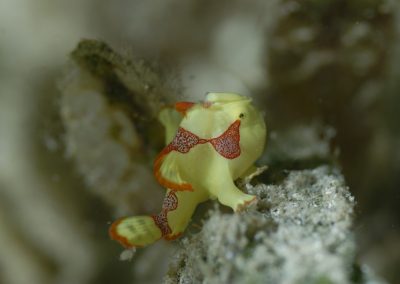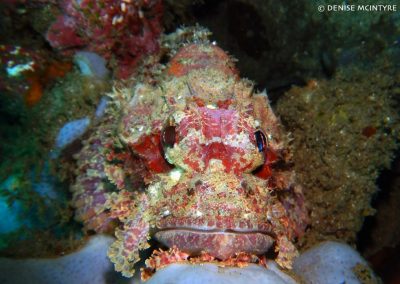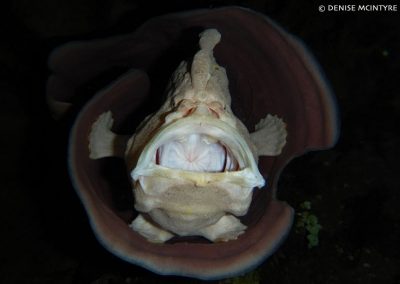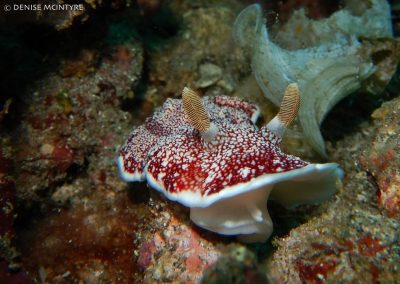Dive Sites
Manado & Bunaken National Park
With many wonderful sites to choose from, the Bunaken Marine Park stretches over 75,000 hectares in the deep waters of the Sulawesi Sea. There are five islands that make up the park, Siladen, Montehage, Nain and of course Bunaken. The fifth one Manado Tua stands out quite literally as it is a magnificent extinct volcano which dominates the four others and the skyline from the panoramic view from our jetty.
The beautiful corals here are to be found surrounding the islands and with a depth from 3 meters to 1300 are home to the many species or sea life to be found here, definitely making this a unique diving experience.
With drift diving being the order of the day, we let you “go with the flow” (we do try to avoid up & down currents where possible!) Let your highly specialized dive guide find you the wonders that so many guests will drift pass. Keep an eye on the “Blue” for larger pelagic.
With the water temperature an all year round 26-29°C it is a destination for all seasons, with March to October being the dry season, and the rainy season starting around November through to March/April. The hottest/sunniest time tends to be June to September, but whatever the Month, don’t forget your sun cream!
Although primarily a dive destination, the shallow reefs are also a haven for many different fish, starfish and corals, possibly even turtles, thus making it a wonderful experience for snorkelers also. With the coral disappearing into the deep, that’s where you will discover so much more! Due to the depths here, we recommend a maximum dive depth of around 25-30 meters, depending on certification.
Here is an idea of some of the dive sites; we do also have a fantastic “house reef” situated a few minutes off the jetty, as well as some other nearby sites that are well worth visiting such as Walet point, Coconut Cove & BMJ.

Mainland Area near Tasik Ria Resort
Critter Circus I
The house reef of Tasik Divers boasts a variety of marine life. Our house reefs spans quite a distance and is broken up into 3 sections.
Upon descending, one may be disappointed to see an abundance of sand and seagrass but don’t be mistaken. The lack of reef does not mean the lack of life. Here, we can find pairs and pairs of Ornate Ghost Pipefishes, Robust Ghost Pipefishes, the elusive Lembeh Sea Dragon, the tiny Shaun the Sheep Nudibranchs, spearing Mantis Shrimps, Peacock Mantis Shrimps and often, multiple cuttlefishes.
Divers have spent 60mins of the dive not moving more than a 20m radius and come up elated!
Critter Circus II
Right next to Critter Circus I is of course, Critter Circus II. They might be next together but the topography is vastly different. This dive site is covered in healthy hard coral. At the start of the dive, you’d be greeted with Staghorn corals (Acropora) that start at around 18m, going up to around 3m in depth. These corals are homes to schools of fusiliers, damselfishes snappers and groupers!
If you’re diving here, don’t forget to take a closer look at the sponges as more often than not, you’d find 1 or 2 Giant Frogfishes camping out! And if you’re lucky, you might even catch one of them yawn.
Tanjung Kelapa
About 20 minutes away by speedboat lies our team’s favourite mainland dive site.
It is said to have some of the richest Marine Life biodiversity, just behind Raja Ampat and Bunaken National park. We start the dive site along a sloping reef with coral bomies, seagrass and patches of sand. Here, we can find an abundance of lionfish, various ghost pipefishes, moray eels, cuttlefishes, nudibranchs and the occasional octopus.
After spending about 20minutes here, the guide would most likely inch toward the mini wall. It is covered in sea fans, whip corals, anemone with school of midnight snappers, blue spotted travellies, bumphead parrotfishes, redtooth triggerfishes and the passing Napolean Wrasse. Many nudibranchs, shrimps and crabs can be found here too.
BMJ (Benny, Melky, Jimmy)
Back in 2001, after the September 11 attack in the US, tourist arrivals in Manado almost drew to a halt. Our guides took the time to explore the local reefs to see if they could find any interesting, undiscovered spots.
Benny, Melky and Jimmy were on the dive and discovered the site, hence the name, BMJ. Deeker, one of our instructors, was on the boat but he had skipped the dive. If you meet him while diving with us, make sure to ask him why there isn’t a D in BMJ. He’s still sore about this.
BMJ is a sloping reef but mostly a much diving site. Take your time and you will a wide range and variety of nudibranchs such as Hypselodoris tryoni, Halgerda batangas, Chromodoris willani, Glossodoris cincta, Hypselodoris apolegma and many more!
Bunaken Island Area
Lekuan 2
There are 3 Lekuan dive sites but Lekuan 2 in particular, is a crowd favourite. Lekuan means elbow, or bend. The dive site is a wall that drops further than one can see. At some points of the site, the wall is less steep and one can see what seems like the bottom. On the walls, you can find scorpion fishes, leaf fish, Gorgorian Seafans and whip corals.
In the blue, have a look out for passing white tip reef sharks and turtles!
Celah Celah
Celah Celah means crack – sort of like the space between tiles on the floor. This dive site is wall dive with cracks that go into the wall by almost 7m. These are caves as there’s always direct excess to the surface, even in the cracks themselves. It definitely is a unique experience to be hovering in the crack while looking out into the blue.
At Celah Celah, in the blue, we also get the usual larger pelagics passing by – White tip reef sharks, black tip reef sharks, eagle rays, green turtles and hawkesbill turtles.
Fukui Point
Fukui Point is the only sloping reef dive site in Bunaken National Park. All other dive sites are walls. Fukui is the name of a Japanese lady who found this dive site many years ago.
At the start of the dive, one would notice some artificial reef formations between 3-8m. Part of the reef was destroyed by unethical fishing methods sometime ago and the damage can still be seen today. These artificial reef formations were set up for coral propagation in an attempt to offset the damage that was done by the illegal fishing. The artificial reef now attracts a school of snappers that tend to stay near the shallows and under the mooring line.
As one continues on the dive, divers will be greeted by stunning healthy corals that are covered in both hard and soft corals. Have a look at the barrel sponges as we often find resting turning in them or on them. At 18-20m (tide dependent), divers can also find a large giant clam! It’s definitely a sight to see.
Bunaken Timur
Timur meets east and this dive site is located at the east of Bunaken National Park. The shallows of this dive site, boasts healthy soft coral and hence the nursery to many juvenile reef fish. So don’t be surprise if your dive guide spends most of their dive at 10m. Unlike the rest of the walls on Bunaken Island, there’s a larger variety of Nudibranchs on these walls. Aside from the various Chromodoris species that are abundant on the walls, have a closer look and you’ll find Coryphillina exoptata, Nembrothas and many more.
Manado Tua (Muka Gereja)
Manado Tua is a volcanic island located to the west of Bunaken Island and still falls within the Bunaken National Park. Tua means old so essentially, Manado Tua is the old Manado. A long time ago, a lot more people lived on Manado Tua but after an eruption, most of it’s population fled towards mainland Manado and live in what is now known as Manado City.
We start the dive in front (muka) of a church (Gereja) and continue as a drift dive – wherever the current takes us. On the walls, have a look out for Giant Frogfish, flatworms, orang utan crabs and nudibranchs and in the blue, as always… the usual pelagics – White tip reef sharks, black tip reef sharks and eagle rays!


